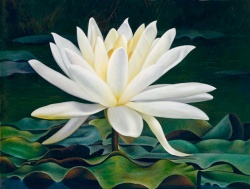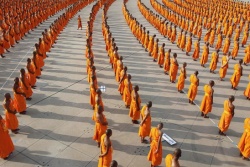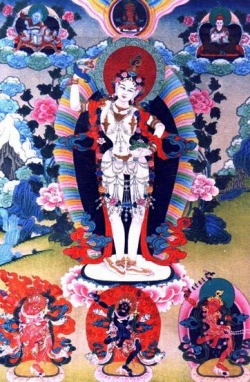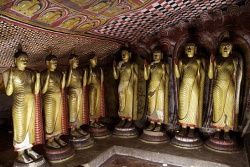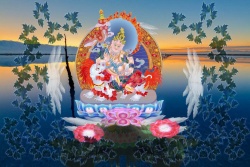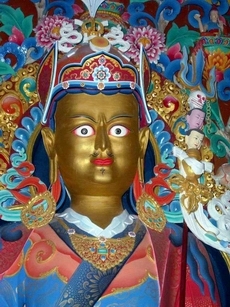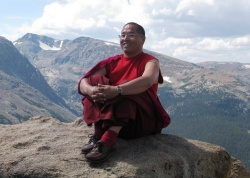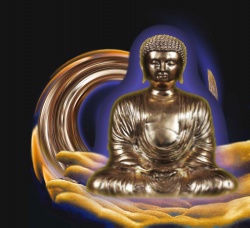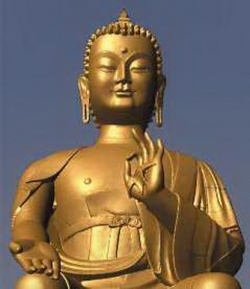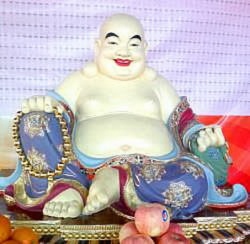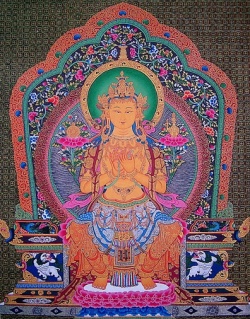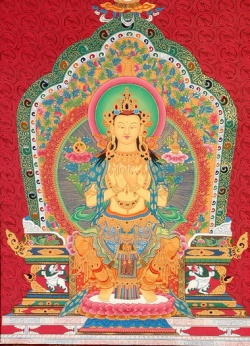Difference between revisions of "White Lotus"
| Line 1: | Line 1: | ||
| − | [[File:WhiteLotus_8.jpg|thumb|250px|]] | + | [[File:WhiteLotus_8.jpg|thumb|250px|]]<nomobile>{{DisplayImages|2525|3621|105|3380|4490|3055|2964|4132}}</nomobile> |
Revision as of 23:58, 9 December 2015
White Lotus (白蓮教 Pinyin: báiliánjiào Wade-Giles: Pai-lien chiao) was a religious and political movement that appealed to many Han Chinese, who found solace in worship of the "Unborn or Eternal Venerable Mother" (trad.: 無生老母, simplified: 无生老母), who was to gather all her children at the millennium into one family.
The Doctrine of the White Lotus included a forecast of the imminent advent of the future Buddha Maitreya.
Origins
The first signs of the White Lotus Society came during the late thirteenth century. Mongol rule over China, known also by its dynastic name, the Yuan dynasty, prompted small, yet popular demonstrations against its rule.
The White Lotus Society took part in some of these protests as they grew into widespread dissent.
The Mongols considered the White Lotus society a heterodox religious sect and banned it, forcing its members to go underground. Now a secret society, the White Lotus became an instrument of quasi-national resistance and religious organization.
The White Lotus Sect may have been one of the main ancestors of the Chinese organization known as the Triads.
The Triads were originally members and soldiers of the Heaven and Earth Society during the period of the War between the Ming and Qing dynasties.
The Triads formation was not for criminal purposes, the original purpose was to overthrow the Qing and restore the Ming to Power.
The White Lotus Society may have been one of five branches of the Heaven Earth Society which formed at the Shaolin temple by Ming Rebels and Loyalists.
The Five branches known by some as the five ancestors were the Black, Red, White, Yellow, and Green Lodges.
After there was no longer any need for Triads on the battlefield, some high level military leaders resorted to criminal activity in order to find means of survival as China's new age in history began.
White Lotus Revolution
A revolution inspired by the White Lotus society, took shape in 1352 around Guangzhou.
A Buddhist monk and former boy-beggar, Zhu Yuanzhang (Wade-Giles: Chu Yüan-chang), joined the rebellion.
His exceptional intelligence took him to the head of a rebel army;
he won people to his side by forbidding his soldiers to pillage in observance of White Lotus religious beliefs. By 1355 the rebellion had spread through much of China.
In 1356, Zhu Yuanzhang captured the important city of Nanjing (then called Jiqing) and made it his capital, renaming it Yingtian 应天.
It was here that he began to discard his heterodox beliefs and so won the help of Confucian scholars who issued pronouncements for him and performed Rituals in his claim of the Mandate of Heaven, the first step toward establishing new dynastic rule.
Meanwhile the Mongols were fighting among themselves, inhibiting their ability to suppress the rebellion.
In 1368, Zhu Yuanzhang extended his rule to Guangzhou, the same year that the Mongol ruler, Toghan Temur, fled to Karakorum.
In 1368, Zhu Yuanzhang and his army entered the former capital of Beijing and in 1371 his army moved through Sichuan to the southwest.
By 1387, after more than thirty years of War, Zhu Yuanzhang had liberated all of China. Having attained the Mandate of Heaven and the status of Emperor, he took the title Hongwu and founded a new dynasty - the Ming.
Later Rebellions
The White Lotus reemerged in the late 18th century in the Form of an inspired Chinese movement in many different forms and sects.
One such large-scale rebellion was led by the female warrior, Wang Cong'er.
In 1774, one instance of a derivative sect, the Eight Trigrams arose in the Form of underground Meditation teachings and practice in Shandong province, not far from Beijing near the city of Linqing.
The leader, herbalist and martial artist Wang Lun, led an uprising that captured three small cities and laid siege to the larger city of Linqing, a strategic location on the north-south Grand Canal transportation route.
After initial success, he was outnumbered and defeated by Qing troops, including local armies of Chinese soldiers known as the Green Standard.
An account of Wang Lun's Death was given to Qing authorities by a captured rebel.
Wang Lun remained sitting in his headquarters wearing a purple robe and two silver bracelets while he burned to Death with his dagger and double-bladed sword beside him.
Wang Lun likely failed because he did not make any attempts to raise wide public support.
He did not distribute captured Wealth or Food supplies, nor did he promise to lessen the tax burden. Unable to build up a support base, he was forced to quickly flee all three cities that he attacked in order to evade government troops.
Though he passed through an area inhabited by almost a million peasants, his army never measured more than four thousand soldiers, many of whom had been forced into service.
In the first decade of the nineteenth century, there were several White Lotus sects active in the area around the capital city of Peking. Although believers had been arrested periodically, there had been no sect-organized violence in the area.
The Eight Trigrams leader Lin Chi'ing united several of these sects and with them build an organization that he would later lead in rebellion.
A movement also arose in the mountainous region that separates Sichuan province from Hubei and Shaanxi provinces in central China as tax protests.
The White Lotus led impoverished settlers into rebellion, promising personal salvation in return for their loyalty. beginning as tax protests, the eventual rebellion gained growing support and sympathy from many ordinary people. The rebellion grew in number and Power and eventually, into a serious concern for the government.
A systematic program of pacification followed in which the populace was resettled in hundreds of stockaded villages and organized into militia.
In its last stage, the Qing suppression policy combined pursuit and extermination of rebel guerrilla bands with a program of amnesty for deserters.
The rebellion came to an end in 1804. A decree from the Emperor Daoguang admitted, "it was extortion by local officials that goaded the people into rebellion..." Using the arrest of sectarian members as a threat, local officials and police extorted money from people.
Actual participation in sect activities had no impact on an arrest; whether or not monetary demands were met, however, did.
Administrators also seized and destroyed sectarian scriptures used by the religious groups. One such official was Huang Yupian (黃育楩), who refuted the ideas found in the scriptures with orthodox Confucian and Buddhist views in A Detailed Refutation of Heresy (破邪詳辯 Pōxié Xiángbiàn), which was written in 1838.
This book has since become an invaluable source in understanding the beliefs of these groups.
The White Lotus Religion in China was largely a Buddhist sect which incorporated some elements of Daoism (Taoism) and other native religions of China.
It arose very early, perhaps going back to the twelfth century. The problem of identifying this Religion's history is a matter of which groups are included. Most groups identified with the White Lotus Religion did not call themselves by that title.
One must also distinguish between the White Lotus societies that were political and nationalistic militias having as little connection with the Religion.
The Irish Republican Army (I.R.A.) in Northern Ireland is supposedly Catholic but it hard to detect any element of Christianity in their actions and behavior.
The White Lotus religious groups initially engaged only in Chanting or reciting Buddhist Sutras or some things akin to Sutras which were supposed to clear the adherents souls and prepare them for entry into the Pure land (Nirvana).
Imperial authorities were very distrustful of such religious groups.
The accusation that became standard was that these groups "practiced eating vegetables and serving devils."
The "eating vegetables" was true; as Buddhists they were, of course, vegetarians.
After centuries of persecution the White Lotus Religion changed. It shifted from being Meditative to being messianic. It began looking toward the arrival of someone who would save them from their persecution.
Any talk of a new leader coming was likely to make the authorities considerably more apprehensive about the sect and increase their persecution.
Finally, in 1796, open rebellion by the White Lotus sects against the Qing government broke out. The rebellion continued for eight years, until 1804. The government put down the rebellion but it was not able to exterminate the sects and the White Lotus Movement.
The White Lotus Religion continued well into the nineteenth century.
In 1842 an offshoot of the White Lotus Movement, called the Nien, rose up in rebellion in Shandong, Henan and Jiangsu provinces.
The leaders chose this time to rebel because the Qing government was pre-occupied with the Taiping Rebellion in south central China.
The Nien Rebellion lasted until 1868, but after 1864 it was doomed.
In 1863 the stronghold of the rebellion, Chih-ho, was taken and its leader, Chang Loxing, was killed.
The Nien Rebellion picked up remnants of the Taiping Rebellion after the Taipings were defeated in 1864, but with the defeat of the Taipings the government could bring the full strength of its army against the Niens. In 1868 the Nien Rebellion was contained.
The groups (Righteous and Harmonious Fists of the Boxer Rebellion of 1900 might have had some affiliation with the militia groups associated in name with the White Lotus religious groups of the past but there is little evidence of an association with the White Lotus religious groups of the past.
The Falun Gong sect of present-day China fits into the scheme of the White Lotus religious groups and the government unjustified persecution of Falun Gong parallels the historic actions of the Qing Empire.
,,,,, Later on, these sects above were knocked down and eliminated or some even extinct as well, Some changed names and some just disappeared.
After the rebellion act in the Ching Dynasty, these were very quiet again but they are STILL going on underground, brewing up new names and new sects.
After China is settled down after the republic era, these sects came out again in new forms.
Famous names for these modern sects of the white Lotus religions are as below:
天德聖教Tien Dei Religion, promote the 5-in-1 Religion. The logo of this Religion looks just like a red Lotus but with “flame and Fire” hidden message. Truly a white Lotus Sect!
天道 Tin dao Religion, about the same as above.
先天道 sin tin dao, pre-Heaven tao Religion, about the same as above.
六壬神功 [[luk yam shen[gong]] – using so called Taoist magic as their main focus
茅山神功 [[mao shan shen[gong]] – about the same as luk yam
佛家神功 fut ga shen gong – about the same as the two above but with Buddhism stuff instead of Taoism and they also promote the possession practice and how they can chop themselves with blades without getting a bleed.
天和正教 tin woh jing gaau - A sect like luk yam shen gong but more gear toward the mao shan magic instead and claim to be a blend of mao shan stuff.
一貫道I Kuan Dao – famous thing brew up with 5-in-1 Religion concept again..
法輪功 FaLun Gong – about the same as I Kuan Dao but more toward the chi kung vibe…
Anything that goes 5-in-1 vibe are most likely the descendent of the white Lotus Religion.
As we had explained and translated in the Zhen Yi and Luk Yam Shen Gong God summoning spells, you see the trace of these vibes.
The white Lotus Religion did not die, it is still there .
This Religion is still in our society today but it is all in new and different names, with new marketing strategies, new brainwashing materials, new way to promote, etc,
For example, those places that favor Buddhism more will need a white Lotus Sect like the I Kuan Dao.
Who promotes more on the Buddhism side. But then in a place like Hong Kong, where Mao Shan and Taoism stuff are more favored, they need something like Luk Yam Shen Gong .How many people got scammed by these white Lotus sects.
When you get in, it’s totally brainwashing you with something else and giving you some Taoism or Buddhism in the scam to make you happy.
They are using words to trick people to get in and join their gangs.
White Lotus Sect or White Lotus Religion had always been blossomed, suppressed and then blossom again in new names. This pattern hand happened in the Ching Dynasty, the republic of China period, and even today’s society.
It had came, gone, and came back again, just in a few new names . There are a lot of sects and lineage out there that are all white Lotus guys too.
